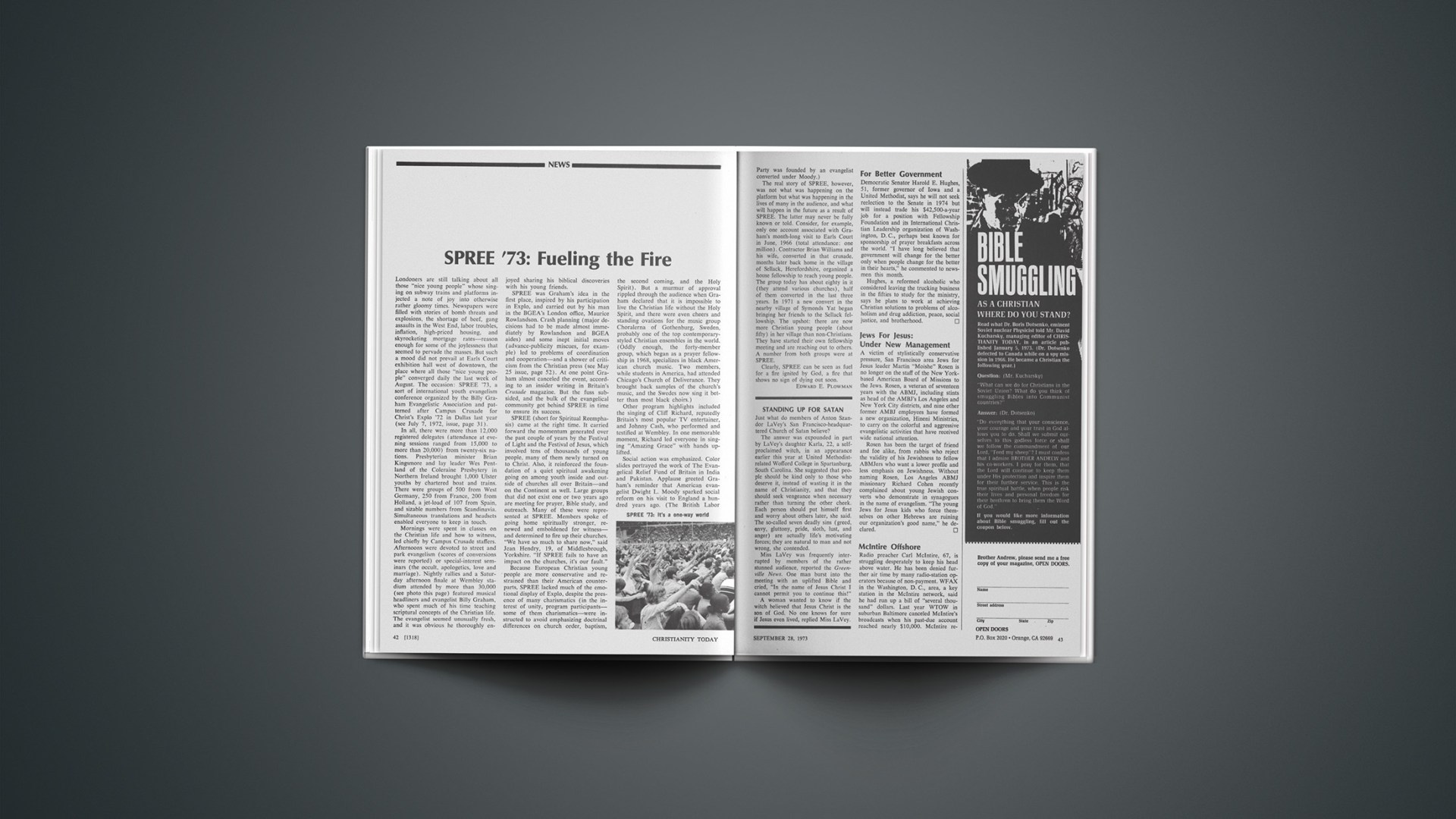J. R. R. Tolkien
Three Rings for the Elven-kings under the sky,
Seven for the Dwarf-lords in their halls of stone,
Nine for Mortal Men doomed to die,
One for the Dark Lord on his dark throne
In the Land of Mordor where the Shadows lie.
One Ring to rule them all, One Ring to find them,
One Ring to bring them all and in the darkness bind them
In the Land of Mordor where the Shadows lie.
For thousands of readers whose imaginations have been joyously baptized into the searing sweetness of romance, fantasy, and Faërie, the death of John Ronald Reul Tolkien on September 2 at the age of eighty-one provides new impetus to reenter his world. Tolkien, one of the leading writers of this literary genre and perhaps one of this century’s most important authors, was born in South Africa, orphaned at the age of twelve, and reared by a guardian, a Roman Catholic priest. He became a teacher, scholar, critic, and “sub-creator.”
For thirty-four years Tolkien taught Old and Middle English language and literature at Oxford; he was Merton Professor of English Language and Literature at the time of his retirement in 1959. In 1922, A Middle English Vocabulary secured his place as a leading international scholar. Tolkien’s edition (along with E. V. Gordon) of Sir Gawayne and the Green Knight is still considered the authoritative text of that cryptic medieval tale. His essay “On Fairy-Stories” (first published in Essays Presented to Charles Williams, edited by his friend and colleague C. S. Lewis) is vital reading for anyone interested in fantasy.
But to most readers Tolkien’s role as sub-creator of other worlds means the most. The stories and poems of Tolkien dance, march, and sing with the texture of a whole, real world. Those who read The Hobbit, The Lord of the Rings, and the poem “The Adventures of Tom Bombadil” live and move and breathe in the unpolluted air of Middle Earth.
In the 1960s college students discovered just how fresh Middle Earth’s air could be. The Tolkien Society sprang up; “Frodo Lives” buttons adorned shirts and sweaters; students renamed dorms “Hobbit holes.” The Tolkien Society produced a poster inviting people to “Come to Middle Earth.” Since Ballantine Books first put out a paperback edition in 1966 of The Lord of the Rings, Tolkien’s masterpiece and best-known creation, the trilogy has sold two million copies. And last year devotees bought 175,000 Tolkien calendars. (Tolkien drew the pictures for the calendar, taken from The Hobbit.) Silmarillon, a work in progress at the time of his death, will be completed by Tolkien’s son Christopher. In the last decade Tolkien’s critical stature as a major literary figure has risen meteorically.
Although Tolkien declared—and most emphatically—that his trilogy had no allegorical elements, the myth and archetypes in The Lord of the Rings reflect an imagination enmeshed with and controlled by the Christian story. As he once remarked to Wheaton English professor Clyde S. Kilby, “I am a Christian and of course what I write will be from that essential viewpoint.”
The choice of Frodo to carry the burden of the ring proves an example of this. “Why was I chosen?” the young Hobbit asks Gandalf the Grey (the wizard who fights the evil Balrog, goes into the pit, and returns alive as Gandalf the White). Gandalf replies, “You may be sure that it was not for any merit that others do not possess: not for power or wisdom, at any rate. But you have been chosen, and you must therefore use such strength and heart and wits as you have.” The explanation reminds the Christian of his own condition: unworthy, yet chosen.
Tolkien was chosen to sub-create, to show why man must do so, and to point implicitly to the Creator, from whom we receive our longing, our desire for light and re-creation. Tolkien explained in “On Fairy-Stories”:
Man, Sub-creator, the refracted Light
through whom is splintered from a single White
to many hues, and endlessly combined
in living shapes that move from mind to mind.
We make still by the law in which we’re made.
In fulfilling his task and completing his quest Tolkien provides the Christian reader with a fresh perspective on the “eucatastrophe” of history, the Resurrection. And he provides the non-Christian with new—or perhaps eternally old—images by which to view the universe. As C. S. Lewis said of myth in general, “I shall never escape this. This will never escape me. These images have struck roots far below the surface of my mind.”
The Tennis Boom And Boon
Mark down the great new enthusiasm for tennis as a plus. Its boom as both a spectator and participant sport is a wholesome social trend.
Many people have become interested in tennis because of the recent Muhammed Ali-like hustling of Bobby Riggs. But its popularity has been rising remarkably for a number of years, and community governments need to be prodded to build more courts. It offers good exercise with low risk of injury and minimal outlay of time and money. Probably no other major sport provides more stimulating one-on-one competition. Chances of regular play are good because only two or four persons are involved, not a hard-to-assemble team. Tennis can be a good family game, playable through a wide age span and, thanks to paved courts and indoor courts, playable over most of the year in most parts of North America.
Tennis might also be said to be easier on the environment than other sports. For one thing, most people can play fairly near their homes; they needn’t use a lot of gas to get to a court. And some sports such as water skiing and car racing can’t get along without pollution-producing engines.
Church congregations should consider setting up leagues and thus encouraging members to participate in this wholesole sport. Many churches could even find room on their property to erect a court or two, which could double as parking space if need be.
Heaven knows most Christians need the exercise!
Humanists Strike Again
The original “Humanist Manifesto” caused a considerable splash when it appeared in 1933. Forty years later, one hundred and twenty philosophers, scientists, authors, social scientists, business leaders and others have signed a new declaration, “Humanist Manifesto II.” The presupposition of these “humanists,” whose numbers include a few clergymen, is that we must begin (and apparently end) “with humans, not God, with nature, not deity.” Faith in the personal God who is interested in us as individuals is “an unproved and outmoded faith.” Needless to say, religion appears to the humanists to be the major obstacle to human progress.
It is difficult to argue with people who make it clear in advance that they automatically reject any evidence against their contentions. We will limit ourselves to observing that if anything is unproved—in fact, incapable of being proved by anyone not himself omniscient—it is their assertion that there is no God; and if anything would appear to be “outmoded” today, it is not interest in a God who answers prayers, but precisely the facile and bloodless moralizing of these manifestants.
As to their proposals, they vary from the unworkable to the absurd. For religious teachings, we are told we should substitute moral values derived from human experience; ethics should be “autonomous and situational, needing no theological or ideological sanction.” Central to their value-scheme is “the preciousness and dignity of the individual person”; “freedom and dignity” are to be enhanced, “exploitative, denigrating forms of sexual expression” disapproved. But from whose human experience shall we derive such values? Quite a few human beings, perhaps the majority, reject them by their deeds as well as in theory. Even among the signers we find “leaders” whose public positions contradict the Manifesto’s moralities: Andrei Sakharov, who helped develop the hydrogen bomb for Moscow, although he is a “severe critic” of the U. S. S. R.; Lawrence Lader, who thinks 600,000 legal abortions in one year a triumph of the human spirit; B. F. Skinner, who tells us to give up the illusionary quest for freedom and dignity; and Albert Ellis, patron of exploitation and denigration.
With so little open-mindedness and objectivity in their starting-point, such scant plausibility in their suggestions, and so much mutual contradictions among themselves, neither these “humanists” nor their Manifesto commend themselves as serious contenders to “serve present-day needs and guide humankind toward the future.”
Unless Someone Raises A Question …
One of the most interesting—and potentially far-reaching—ethical precepts of the Apostle Paul is briefly stated in his reply to a question about eating meat as someone’s guest when you have every reason to believe the meat has previously been in some pagan ceremony (1 Cor. 10:25–30; see related editorial, July 20 issue, page 30).
Paul indicates that in certain circumstances it is just as well not to be overzealous in inquiring about accessory details. If you inquire whether the meat has been offered to idols, you imply that if it has you can’t eat it. Similarly, Christians can rent halls in which to hold meetings without inquiring whether the same hall has been used for meetings of other religions. But can Christians allow their own buildings to be used by others? Most would probably hesitate to allow non-Christian religious services because it could imply indifference to the unique claims of Christ. But on letting facilities be used for weddings of non-Christians or for meetings of scout troops, opinions are divided. Questions also arise on the use of actors in films intended to communicate Christian truth. Do we evaluate only the finished product, or look closely into the behavior and beliefs of the actors involved? Why stop at actors? Do the technicians have to be Christians, too?
But although Paul says we are not to raise unnecessary questions, he recognizes that the non-Christian might. If one’s host at dinner says, “This [meat] has been offered in [pagan] sacrifice” (v. 28), then we are to refrain from eating it. If he keeps quiet, we keep quiet and enjoy the food. If he raises a question, presumably because he thinks Christians ought not to be involved in this kind of activity, then we abstain.
We are not normally to let our behavior be determined by what we think to be another man’s (ill-founded) scruples. But if he verbalizes his scruples, then we give way. This Pauline precept is simultaneously both more lax and more strict than the practice of many, if not most, Christians. Paul has the freedom to do anything for which he can, as a mature Christian, give thanks to God, growing out of a knowledge of God’s Word, such as recognizing that “the earth is the Lord’s, and everything in it” (v. 26). But at the same time he restricts his behavior in the presence of obviously weaker brethren or question-raising non-believers in order not to lead them astray until such time as their understanding of Christian ethics can be improved. The right combination of liberty and restraint is what all Christians should aim for.
The NIV style
The value of a modern translation of the New Testament is chiefly determined by the level of scholarship, theological learning, and spiritual insight of the translators. Yet the Bible-reading public makes its judgment largely on the basis of style. When a literate but theologically unlearned reader says of a version that he does or does not “like” it, he is almost invariably responding to such literary features as rhythm, vocabulary, tone, imagery, syntactical structure, parallelism. Over the centuries tens of thousands of readers of the King James Version have been captivated by its style, whether they believe a word of what it says or not.
Quite rightly, therefore, the translators of the New International Version (see review, page 25) have paid careful attention to the literary garments (the form) in which they have clothed their content; and, fortunately, the group includes scholars of the keenest literary sensibility. They know that translation is a fearfully difficult task, requiring not only the transfer of meaning from the original words to another language so that the reader may be informed, but also the rebreathing of life and beauty into the new version so that the reader may, as well, be moved. To their task, they have brought the first requirement listed by Matthew Arnold for those who wish to translate Homer: they have been “penetrated by a sense of the … [stylistic] qualities” of their authors. And they have deftly reflected the differences between the original styles of, say, Luke and Peter, the former sophisticated in the literary devices of classical rhetoric, and the latter blunt, powerful, and terse.
High on the list of stylistic characteristics of the NIV is a kind of economical integrity, a quality of simple dignity, of tightly drawn texture, “wov’n close, both matter, form and stile,” to quote Milton in another connection. Here is no straining after catchy colloquialism, shirt-sleeve casualness, or perky slang. There is presumably a place among modern versions for a colloquial style and for relaxed paraphrase; but in the NIV one senses that the translators put integrity and directness first.
This is not to say that it is without a style of its own, for to make simplicity moving one must adorn it with appropriate aesthetic devices. Chief among these in the NIV, I think, is rhythm. Care has obviously been taken with flow, with rise and fall, and with the effect that connectives have in linking one rhythm to another. Perhaps it is mere personal prejudice, but I appreciate the translators’ unwillingness to depart from the King James Version, particularly when the rhythm is lovely, without good cause. You can track these men everywhere in the snow of their seventeenth-century predecessors—to paraphrase what Dryden said of Jonson’s dependence on the ancients. As a result, in such touchstone passages as First Corinthians 13 and John 14, the reader enjoys the pleasure of freshness with the comfort of a tested friendship.
By its combination of integrity, dignity, and stylistic felicity, the NIV will read as well on solemn occasions as in private devotions.—CALVIN D. LINTON, professor of English literature and dean of arts and sciences, The George Washington University, Washington, D. C.









